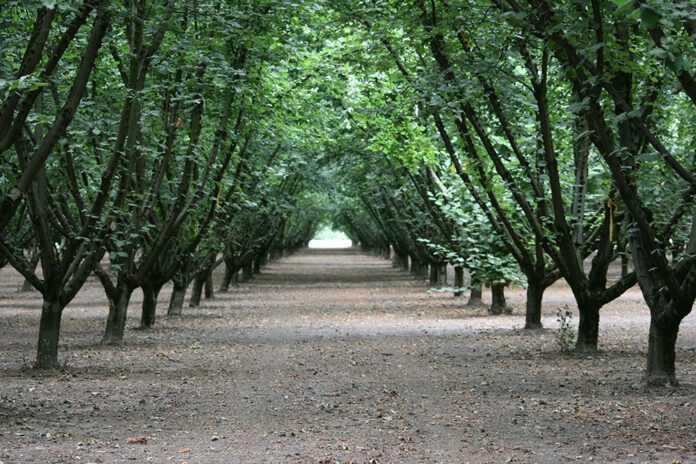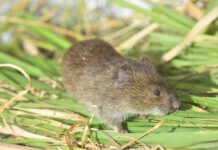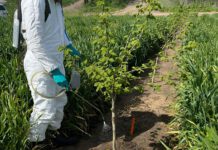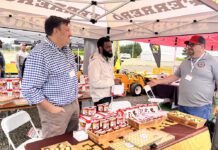In 2012, with drought ravaging water resources in California, the almond industry was widely targeted for supposed overconsumption of water, said Gabriele Ludwig, director of sustainability and environmental affairs for the Almond Board of California.
Speaking at the Nut Growers Society Winter Meeting, January 10 in Grand Ronde, Ore., Ludwig said fortunately, three years prior to the 2012 drought, the Almond Board had launched the California Almond Stewardship Platform, or CASP (then called the California Almond Sustainability Program), and the organization had data showing the accusations were unfounded.
Ludwig’s presentation and a subsequent presentation from James McDonald, past president of the Nut Growers Society, were part of an effort by hazelnut industry leaders to improve participation in the Hazelnut Stewardship Program.
Providing consumers and buyers with a window into the stewardship practiced on Pacific Northwest hazelnut farms can only serve to improve public perception of the industry and could potentially increase crop value, McDonald said. He added participating in the program has very little downside.
To start with, he said, growers can be assured that data they submit is confidential.
“I can tell you our family farm, under both my direction and that of my father… has contributed the requested information to this program and not once have we felt like our information has been compromised,” McDonald said. “In fact, only four people out of 8 billion people have access to your information. I’d say that’s better than your bank account information, your Social Security information, your mother’s maiden name, what have you.”
He added participating in the Hazelnut Stewardship Program is not overly burdensome. Particularly after the initial compilation, which takes a little longer to complete than subsequent compilations, growers can fill in the necessary data in a short amount of time, McDonald said.
“When there is a wet and rainy day, sit down with a cup of coffee, log into your computer and put that information in, and I think we’re all going to reap the benefits of this program,” McDonald said.
As for the upsides, he said there are plenty, including an opportunity to show buyers and consumers the efforts hazelnut growers take to be stewards of the environment. “And in a world where farmers are under such a microscope, I think that is a really good thing for us,” McDonald said.
“We do things that aren’t the fastest or the cheapest,” he said. “Why not get applauded for these extra efforts and tell the world in this stewardship program what we do. Otherwise, people might have no idea that we care so darn much.”
He added that better participation could also help open new markets and bring higher prices for hazelnuts. “If we can get 25% participation, we as an industry can leverage the world market to get more cash per pound,” McDonald said.
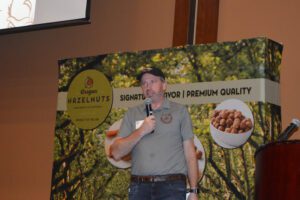
Critical Information
Ludwig in her presentation noted in today’s market environment, it has become critical for growers to show food companies and consumers they are producing crops sustainably. And, she said, because the tree nut industry has been touting the health benefits of nuts for many years now, consumers expect the industry’s “healthy for me” message to also be “healthy for the environment.”
Also, Ludwig said, two of the biggest markets for tree nuts, North America and Europe, are leading the charge in demanding sustainable food production.
“You need to think about who’s doing the buying and what consumers are looking for in their food, and what are those food companies looking for,” Ludwig said. “Europe, in particular, is getting more demand in this space, but North American companies are not that far behind. CASP has been a mechanism for almond handlers to sign up and obtain data, again anonymously, from their growers who have volunteered to share their data with the handler.
“So again, having data to show that you are working on being a good steward of the land is critical as buyers ask more questions,” she said.
Additionally, Ludwig said, many food companies have established internal goals for reducing their carbon footprint, and in most cases, most of their footprint comes from the growing side of the equation; thus, companies need help from growers to meet their carbon-reduction goals.
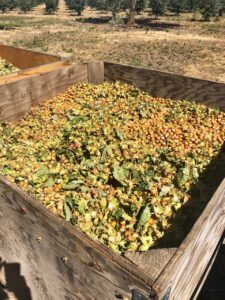
And, she said, regulations are starting to come into play. “In the last two or three years, we are starting to get regulations,” she said. The big driver is Europe, she said. There, companies are being required to publicly report their greenhouse gas emissions, and they need to talk about what they are doing to reduce their carbon footprint.
Ludwig added, “At the end of the day, what this comes down to, whether it is your handler, your processor dealing with the customer or whether it is your growers’ association, they cannot tell your story unless you take the time to write it down and share it.
“And I realize that is not what you signed up for as a grower, to write things down,” she said. “But it doesn’t matter what you’re doing on the farm unless you write it down and share it. No one knows, and you will not get credit for it.”
Another benefit of an industry-wide stewardship program, McDonald said, is growers can learn from it. By comparing a farm’s information with the aggregate, growers “might learn something new that can make your farm more profitable or get insight on how to do things differently or in a better way,” McDonald said.
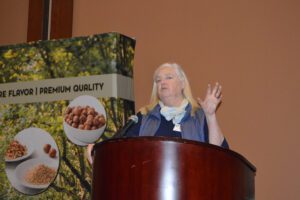
Ludwig noted through CASP, which has 30% of almond acres assessed and represents about 50% of the total almond acreage in California, growers for years have gained insight from their participation in CASP’s self-assessment program.
Ludwig added when ABC launched the program, it was not well received. “I was there with growers whose arms had been twisted to be in the room, and they sat there and looked at me like, ‘What are you doing?’” Ludwig said. “But when they sat down and actually did the self-assessment, they all said, ‘Wow, this was actually helpful. It made me reflect on some things that I just haven’t thought about or considered doing on my farm.’
“Something none of us like doing is taking time to reflect about how we are doing things,” Ludwig added. “Doing the self-assessment is actually an opportunity to do that. Especially with the report that gives a sense of how a grower’s practices compare with the aggregate of participants.”
For more information on the Hazelnut Stewardship Program or to create an account, growers can go to hazelnutstewardship.org.







